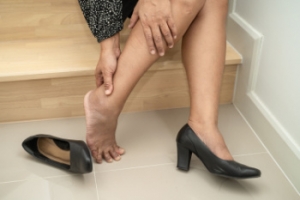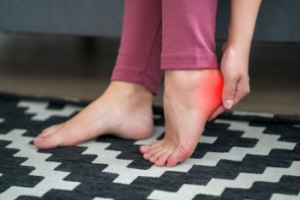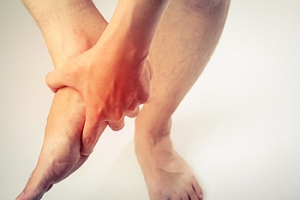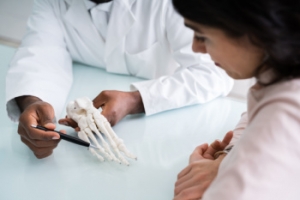
How Shoe Choice Can Cause Hind-Foot Pain
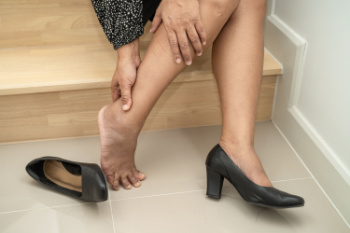 Wearing improper footwear, particularly shoes that lack adequate support or fit poorly, can significantly contribute to hind-foot pain. High heels and narrow-toed shoes, while fashionable, can place excessive stress on the structures of the hind-foot. The heel and ankle are two particularly susceptible areas for pain. Wearing these kinds of shoes can also lead to conditions like plantar fasciitis, Achilles tendonitis, and bursitis. These styles force the foot into an unnatural position, disrupting alignment and increasing pressure on the back of the foot. Stress on the foot over time not only leads to pain and discomfort but also can significantly affect mobility and quality of life. It is important to choose shoes with proper support, cushioning, and a fit that accommodates the natural shape of the foot to prevent hind-foot pain. Podiatrists often stress the importance of wearing shoes that complement one's lifestyle as well as provide the foundation for healthy foot posture and function. If you are experiencing pain in the back of the foot, it is suggested that you visit a podiatrist for a full diagnosis and proper shoe recommendations to support your recovery.
Wearing improper footwear, particularly shoes that lack adequate support or fit poorly, can significantly contribute to hind-foot pain. High heels and narrow-toed shoes, while fashionable, can place excessive stress on the structures of the hind-foot. The heel and ankle are two particularly susceptible areas for pain. Wearing these kinds of shoes can also lead to conditions like plantar fasciitis, Achilles tendonitis, and bursitis. These styles force the foot into an unnatural position, disrupting alignment and increasing pressure on the back of the foot. Stress on the foot over time not only leads to pain and discomfort but also can significantly affect mobility and quality of life. It is important to choose shoes with proper support, cushioning, and a fit that accommodates the natural shape of the foot to prevent hind-foot pain. Podiatrists often stress the importance of wearing shoes that complement one's lifestyle as well as provide the foundation for healthy foot posture and function. If you are experiencing pain in the back of the foot, it is suggested that you visit a podiatrist for a full diagnosis and proper shoe recommendations to support your recovery.
Foot Pain
Foot pain can be extremely painful and debilitating. If you have a foot pain, consult with Milos Tomich, DPM from Dr. Tomich Foot & Ankle Health Center. Our doctor will assess your condition and provide you with quality foot and ankle treatment.
Causes
Foot pain is a very broad condition that could be caused by one or more ailments. The most common include:
- Bunions
- Hammertoes
- Plantar Fasciitis
- Bone Spurs
- Corns
- Tarsal Tunnel Syndrome
- Ingrown Toenails
- Arthritis (such as Gout, Rheumatoid, and Osteoarthritis)
- Flat Feet
- Injury (from stress fractures, broken toe, foot, ankle, Achilles tendon ruptures, and sprains)
- And more
Diagnosis
To figure out the cause of foot pain, podiatrists utilize several different methods. This can range from simple visual inspections and sensation tests to X-rays and MRI scans. Prior medical history, family medical history, and any recent physical traumatic events will all be taken into consideration for a proper diagnosis.
Treatment
Treatment depends upon the cause of the foot pain. Whether it is resting, staying off the foot, or having surgery; podiatrists have a number of treatment options available for foot pain.
If you have any questions, please feel free to contact one of our offices located in Milwaukee and Wauwatosa, WI . We offer the newest diagnostic and treatment technologies for all your foot care needs.
Foot Pain
The feet, being the foundation of the body, carry all of the body’s weight and are therefore prone to experiencing pain and discomfort. If you are experiencing foot pain, it is important to determine where in the foot you are experiencing this pain to help discover the cause of it. While pain can be experienced virtually anywhere in the foot, the most common sites of foot pain are in the heel and ankle.
Heel pain can be due to a multitude of conditions including plantar fasciitis, Achilles tendinitis, and heel spurs. Pain experienced in the ankle can be a sign of an ankle sprain, arthritis, gout, ankle instability, ankle fracture, or nerve compression. In more serious cases, pain in the foot can be a sign of improper alignment or an infection.
Foot pain can be accompanied by symptoms including redness, swelling, stiffness and warmth in the affected area. Whether the pain can be described as sharp or dull depends on the foot condition behind it. It is important to visit your local podiatrist if your foot pain and its accompanying symptoms persist and do not improve over time.
Depending on the location and condition of your foot pain, your podiatrist may prescribe certain treatments. These treatments can include but are not limited to prescription or over-the-counter drugs and medications, certain therapies, cortisone injections, or surgery.
If you are experiencing persistent foot pain, it is important to consult with your foot and ankle doctor to determine the cause and location. He or she will then prescribe the best treatment for you. While milder cases of foot pain may respond well to rest and at-home treatments, more serious cases may take some time to fully recover.
Ankle Joint Replacement Surgery for Arthritis Relief
 Joint replacement for ankle arthritis is a surgical option for those suffering from severe arthritis in their ankle. The point of the replacement surgery is to relieve pain and restore the function of the ankle. Arthritis is characterized by the breakdown of cartilage that cushions the ends of the bones, leading to pain, stiffness, and reduced mobility. During ankle joint replacement surgery, also known as ankle arthroplasty, the damaged parts of the ankle bones are removed and replaced with artificial components. These components mimic the natural movement of the ankle, offering patients the chance to regain mobility. This procedure is considered when less invasive treatments have failed to provide relief. It is also considered mostly for older, less active patients. Joint replacement can significantly reduce pain and improve the ankle's function, making it a valuable treatment option for those with advanced ankle arthritis. If you are suffering from arthritis in the ankle, it is suggested that you schedule an appointment with a podiatrist to discuss whether ankle replacement surgery is right for you.
Joint replacement for ankle arthritis is a surgical option for those suffering from severe arthritis in their ankle. The point of the replacement surgery is to relieve pain and restore the function of the ankle. Arthritis is characterized by the breakdown of cartilage that cushions the ends of the bones, leading to pain, stiffness, and reduced mobility. During ankle joint replacement surgery, also known as ankle arthroplasty, the damaged parts of the ankle bones are removed and replaced with artificial components. These components mimic the natural movement of the ankle, offering patients the chance to regain mobility. This procedure is considered when less invasive treatments have failed to provide relief. It is also considered mostly for older, less active patients. Joint replacement can significantly reduce pain and improve the ankle's function, making it a valuable treatment option for those with advanced ankle arthritis. If you are suffering from arthritis in the ankle, it is suggested that you schedule an appointment with a podiatrist to discuss whether ankle replacement surgery is right for you.
In certain cases, in which the patient suffers from extreme pain or damage in a joint, joint replacement surgery may be deemed useful. If you have constant pain in a foot joint, consult with Milos Tomich, DPM from Dr. Tomich Foot & Ankle Health Center. Our doctor will assess your condition and provide you with quality foot and ankle treatment.
What Is Joint Replacement Surgery?
Over time, joints wear down; this can be exacerbated by diseases and conditions. Joint replacement surgery, also known as arthroplasty, is when a damaged joint is surgically removed and replaced with a prosthesis. Prostheses, which can be made of ceramic, plastic, or metal, act as joints in lieu of an actual joint. One of the most prevalent causes for joint replacement is arthritis.
Arthritis in the Foot
Arthritis can occur in any joint in the body, including in the feet. Common types of arthritis in the foot are osteoarthritis, rheumatoid arthritis, and gout. The big toe is usually where arthritis occurs in the foot; this is known as hallux rigidus.
Joint Replacement Surgery in the Foot
The most common form of joint replacement in the foot is a first metatarsophalangeal (MTP) joint placement. MTP joint replacement surgery is designed to treat hallux rigidus. Surgery is not intensive, and recovery occurs within one to two months after the procedure has been done. Overall, joint replacement surgery is a safe and effective way to treat pain in the joint of the foot.
If you have any questions, please feel free to contact one of our offices located in Milwaukee and Wauwatosa, WI . We offer the newest diagnostic and treatment technologies for all your foot care needs.
Joint Replacement Surgery
When conservative, noninvasive treatments prove unsuccessful, podiatrists will often turn to surgery as the last line of treatment for their patients. If patients are suffering from joint pain, issues in mobility, or are seeking to correct a deformity, joint replacement surgery is an effective option. Joint replacement surgery is also successful in treating arthritis, which is the most common cause of improperly working joints.
Patients with symptoms that include joint pain, stiffness, limping, muscle weakness, limited motion, and swelling are typically considered for joint replacement surgery. Range of motion and activity post-surgery will vary between patients and depending on the specific surgery performed, the affected joint, and the damage that will need to be repaired.
Joint replacement surgery replaces the damaged cartilage and bone, the latter if required. The damaged cartilage is typically replaced with a prosthesis that is attached to the bone, allowing the implant to grow into the bone. Following surgery, the patient will typically undergo physical therapy to become familiar with movement using the replaced joint.
Conditions Associated With Heel Spurs
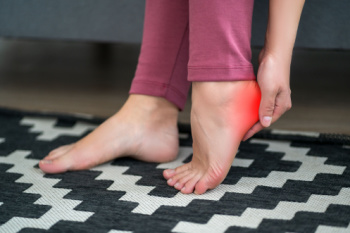 Heel spurs are bony growths that develop on the underside of the heel bone, often near the point where the plantar fascia connects to the bone. While they can be asymptomatic, heel spurs are frequently associated with certain foot conditions, serving as indicators of underlying issues. Primarily, they're linked with plantar fasciitis, a condition where the ligament running along the bottom of your foot becomes inflamed and causes heel pain. This inflammation can lead to the development of a spur. Heel spurs are also frequently associated with chronic conditions stemming from strain on the foot muscles and ligaments, or from repeated tearing of the membrane that covers the heel bone. Such strain and tearing can be due to excessive weight, poor shoe choices, or an active lifestyle without adequate foot support. The association of heel spurs with other conditions typically means there will be a comprehensive approach to treatment, which may include stretches, orthotic support, or lifestyle modifications to address the root cause of the pain. If you are suffering from a heel spur, it is suggested you make an appointment with a podiatrist who can diagnose the underlying problem and help you find relief.
Heel spurs are bony growths that develop on the underside of the heel bone, often near the point where the plantar fascia connects to the bone. While they can be asymptomatic, heel spurs are frequently associated with certain foot conditions, serving as indicators of underlying issues. Primarily, they're linked with plantar fasciitis, a condition where the ligament running along the bottom of your foot becomes inflamed and causes heel pain. This inflammation can lead to the development of a spur. Heel spurs are also frequently associated with chronic conditions stemming from strain on the foot muscles and ligaments, or from repeated tearing of the membrane that covers the heel bone. Such strain and tearing can be due to excessive weight, poor shoe choices, or an active lifestyle without adequate foot support. The association of heel spurs with other conditions typically means there will be a comprehensive approach to treatment, which may include stretches, orthotic support, or lifestyle modifications to address the root cause of the pain. If you are suffering from a heel spur, it is suggested you make an appointment with a podiatrist who can diagnose the underlying problem and help you find relief.
Heel spurs can be incredibly painful and sometimes may make you unable to participate in physical activities. To get medical care for your heel spurs, contact Milos Tomich, DPM from Dr. Tomich Foot & Ankle Health Center. Our doctor will do everything possible to treat your condition.
Heels Spurs
Heel spurs are formed by calcium deposits on the back of the foot where the heel is. This can also be caused by small fragments of bone breaking off one section of the foot, attaching onto the back of the foot. Heel spurs can also be bone growth on the back of the foot and may grow in the direction of the arch of the foot.
Older individuals usually suffer from heel spurs and pain sometimes intensifies with age. One of the main condition's spurs are related to is plantar fasciitis.
Pain
The pain associated with spurs is often because of weight placed on the feet. When someone is walking, their entire weight is concentrated on the feet. Bone spurs then have the tendency to affect other bones and tissues around the foot. As the pain continues, the feet will become tender and sensitive over time.
Treatments
There are many ways to treat heel spurs. If one is suffering from heel spurs in conjunction with pain, there are several methods for healing. Medication, surgery, and herbal care are some options.
If you have any questions feel free to contact one of our offices located in Milwaukee and Wauwatosa, WI . We offer the latest in diagnostic and treatment technology to meet your needs.
Heel Spurs
Heel spurs are the result of calcium deposits that cause bony protrusions on the underside of the heel. Heel spurs are usually painless, but they have the potential to cause heel pain. Heel spurs tend to be associated with plantar fasciitis, which is a condition that causes inflammation of the band of connective tissue that runs along the bottom of the foot. They most often occur to athletes whose sports involve a lot of running and jumping.
Some risk factors for developing heel spurs include running and jogging on hard surfaces, being obese, wearing poorly fitting shoes, or having walking gait abnormalities.
It is possible to have a heel spur without showing signs of any symptoms. However, if inflammation develops at the point of the spur’s formation, you may have pain while walking or running. In terms of diagnosis, sometimes all a doctor needs to know is that the patient is experiencing a sharp pain localized to the heel to diagnose a heel spur. Other times, an x-ray may be needed to confirm the presence of a heel spur.
Heel spurs can be prevented by wearing well-fitting shoes that have shock-absorbent soles. You should also be sure that you are choosing the right shoe for the activity you want to partake in; for example, do not wear walking shoes when you want to go on a run. Additionally, maintaining a healthy weight can be beneficial toward preventing heel spurs, as it will prevent an excess amount of pressure being placed on the ligaments.
There are a variety of treatment options for people with heel spurs. Some of these include stretching exercises, physical therapy, shoe inserts, or taping and strapping to rest stressed muscles and tendons. If you have heel pain that lasts longer than a month, don’t hesitate to seek help from a podiatrist. Your doctor can help you determine which treatment option is best for you.
Plantar Fasciitis and Heel Pain
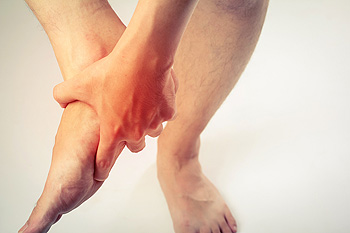 Plantar fasciitis is a primary cause of heel pain in adults. The pain stems from the inflammation of the plantar fascia, a band of tissue that spans the bottom of the foot and connects the heel bone to the toes. This condition typically results from repetitive strain and overstretching of the plantar fascia. It is often exacerbated wearing inadequate footwear, obesity, and activities that place excessive stress on the foot. The pain is usually most intense with the first few steps in the morning or after periods of rest. It stems from micro-tears and inflammation within this critical support structure of the foot. As the plantar fascia bears the brunt of every step's impact, its compromised state can significantly hinder mobility and quality of life. Effective management and treatment hinge on a comprehensive approach that may include rest, anti-inflammatory medications, stretching exercises, and possibly orthotic support. If you are suffering from heel pain, it is suggested that you consult with a podiatrist. This type of doctor has specialized knowledge of the foot and ankle, and can diagnose plantar fasciitis and offer personalized treatment solutions.
Plantar fasciitis is a primary cause of heel pain in adults. The pain stems from the inflammation of the plantar fascia, a band of tissue that spans the bottom of the foot and connects the heel bone to the toes. This condition typically results from repetitive strain and overstretching of the plantar fascia. It is often exacerbated wearing inadequate footwear, obesity, and activities that place excessive stress on the foot. The pain is usually most intense with the first few steps in the morning or after periods of rest. It stems from micro-tears and inflammation within this critical support structure of the foot. As the plantar fascia bears the brunt of every step's impact, its compromised state can significantly hinder mobility and quality of life. Effective management and treatment hinge on a comprehensive approach that may include rest, anti-inflammatory medications, stretching exercises, and possibly orthotic support. If you are suffering from heel pain, it is suggested that you consult with a podiatrist. This type of doctor has specialized knowledge of the foot and ankle, and can diagnose plantar fasciitis and offer personalized treatment solutions.
Many people suffer from bouts of heel pain. For more information, contact Milos Tomich, DPM of Dr. Tomich Foot & Ankle Health Center. Our doctor can provide the care you need to keep you pain-free and on your feet.
Causes of Heel Pain
Heel pain is often associated with plantar fasciitis. The plantar fascia is a band of tissues that extends along the bottom of the foot. A rip or tear in this ligament can cause inflammation of the tissue.
Achilles tendonitis is another cause of heel pain. Inflammation of the Achilles tendon will cause pain from fractures and muscle tearing. Lack of flexibility is also another symptom.
Heel spurs are another cause of pain. When the tissues of the plantar fascia undergo a great deal of stress, it can lead to ligament separation from the heel bone, causing heel spurs.
Why Might Heel Pain Occur?
- Wearing ill-fitting shoes
- Wearing non-supportive shoes
- Weight change
- Excessive running
Treatments
Heel pain should be treated as soon as possible for immediate results. Keeping your feet in a stress-free environment will help. If you suffer from Achilles tendonitis or plantar fasciitis, applying ice will reduce the swelling. Stretching before an exercise like running will help the muscles. Using all these tips will help make heel pain a condition of the past.
If you have any questions please contact one of our offices located in Milwaukee and Wauwatosa, WI . We offer the newest diagnostic and treatment technologies for all your foot and ankle needs.
Heel Pain
Heel pain can be difficult to deal with, especially if you do not know what the underlying cause is. If you ignore your heel pain, the pain can magnify and potentially develop into a chronic condition. Depending on the location of your heel pain, you have developed a specific condition.
One condition is plantar fasciitis. Plantar fasciitis is caused by the inflammation of the plantar fascia, or the band of tissue that connects the heel bone to the base of the toes. The pain from this condition is initially mild but can intensify as more steps are taken when you wake up in the morning. To treat this condition, medication will likely be necessary. Plantar fasciitis is often associated with heel spurs; both require rest and special stretching exercises.
There are various options your podiatrist may suggest for heel pain. Treatment options for heel pain typically include non-steroidal anti-inflammatory drugs (NSAIDS), which may reduce swelling and pain. Other options are physical therapy, athletic taping, and orthotics. In severe cases of heel pain, surgery may be required.
Preventing heel pain is possible. If you are looking to prevent heel pain from developing in the future, be sure to wear shoes that fit you properly and do not have worn down heels or soles. Be sure to warm up properly before participating in strenuous activities or sports that place a lot of a stress on the heels. If you are experiencing any form of heel pain, speak with your podiatrist to determine the underlying cause and receive the treatment you need.
The Importance of Podiatrists on Healthcare Teams
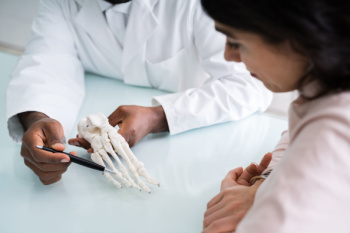
Podiatrists specialize in diagnosing and treating conditions related to the foot, ankle, and lower leg. Podiatrists play an important role on a healthcare team, as their specialty can help patients maintain and enhance mobility and overall quality of life. Podiatrists’ specialized knowledge of foot-related disorders ranges from common issues, such as ingrown toenails and bunions, to more complex conditions like diabetic foot and structural abnormalities. Podiatrists take a comprehensive approach to treatment, by conducting thorough assessments, implementing various treatment methodologies, and creating personalized care plans. Podiatrists not only address acute and chronic pain but also offer prevention techniques for various conditions. This is important care to receive for conditions that could result in mobility restrictions or more invasive treatments. Overall, podiatrists ensure that our feet, which bear the brunt of our daily activities, receive the specialized care necessary to keep us walking and running through life. If you’re experiencing any foot or ankle-related issues, it is suggested you add a podiatrist to your healthcare team.
If you are experiencing pain in the feet or ankles, don’t join the stubborn majority refusing treatment. Feel free to contact Milos Tomich, DPM from Dr. Tomich Foot & Ankle Health Center. Our doctor can provide the care you need to keep you pain-free and on your feet.
What Is a Podiatrist?
Someone would seek the care of a podiatrist if they have suffered a foot injury or have common foot ailments such as heal spurs, bunions, arch problems, deformities, ingrown toenails, corns, foot and ankle problems, etc.
Podiatric Treatment
A podiatrist will treat the problematic areas of the feet, ankle or lower leg by prescribing the following:
- Physical therapy
- Drugs
- Orthotic inserts or soles
- Surgery on lower extremity fractures
A common podiatric procedure a podiatrist will use is a scanner or force plate which will allow the podiatrist to know the designs of orthotics. Patients are then told to follow a series of tasks to complete the treatment. The computer will scan the foot a see which areas show weight distribution and pressure points. The podiatrist will read the analysis and then determine which treatment plans are available.
If you have any questions please feel free to contact one of our offices located in Milwaukee and Wauwatosa, WI . We offer the newest diagnostic and treatment technologies for all your foot and ankle needs.

